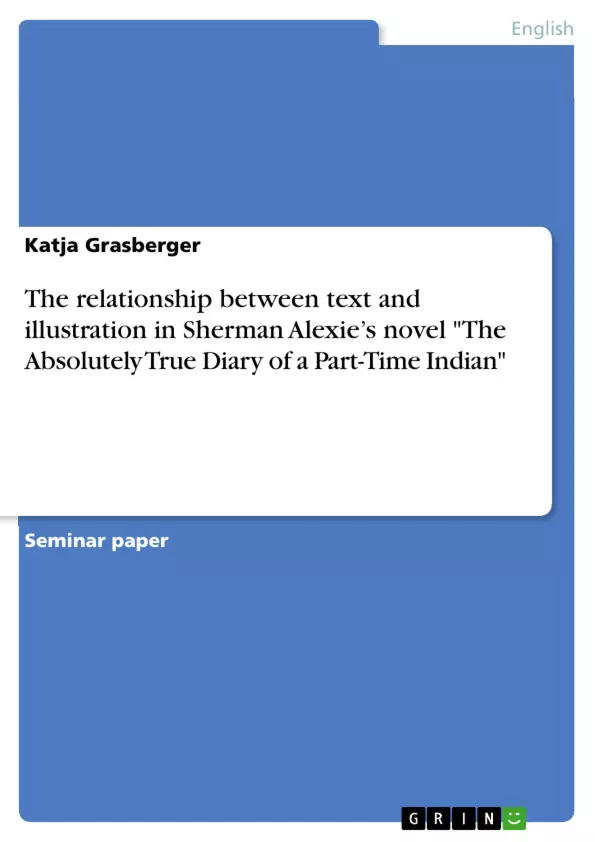The following paper will deal with the relationship between text and illustrations in Sherman Alexie’s novel “The Absolutely True Story of a Part-Time Indian.”
Sherman Alexie is a Native American, which he prefers to call Indians, and grew up on the Spokane Reservation, which is also the setting in the novel. His novel partially tells his own story which means it is semi-autobiographical. One of the main topics of his novels, and also very present in this novel, is alcoholism, probably because his father had an alcohol problem as well. It is important to mention that Alexie’s novel is not a comic in the first place, because it mainly shows single illustrations which contribute to the text’s meaning. It is therefore a graphic novel meaning that it is a narrative with occasional pictures with a dominance of verbal elements.
However, there are still five actual comics in the book. Not only writing novels but also poems and short stories his novels present the “nobly suffering Indian“ (Campbell) but also the “hard reality of urban life“ (Campbell) by also telling the hard naked truth about being Indian.
Comics have been out there for several decades, but they have not always enjoyed a broad audience. The genre of comics is often readily dismissed as being for children, young male adolescents and even for sub-literates. This marginalized genre is more than that; it offers topics and themes for everyone, varying from fiction to politics, fantasy, erotica, essays, autobiography and many more. As Douglas Wolk puts it: “comics have grown up“. As comics went through a long development of experiencing setbacks and success at the same time, today we have shops exclusively for cartoons, comics or illustrations.
As modern literature and culture changed into being more visual and less written the genre of comics and illustrations has become more attractive and popular. Moreover since the Marvel and DC comics and especially their remakes as movies such as Spiderman, Thor, Ironman, Captain America, Avengers, Watchmen, Sin City and many more the genre became more accessible for people who have not had a huge interest in comics beforehand. Although comics are drawn and represent a picture “we read comics. [...] holding them in our hands, turning their pages“ (Wolk). When in the 1970s the main topics were “simplistic superhero fantasies or violence“ (Bongco) the genre today is also dealing with serious topics.
Table of Contents
- Introduction
- Illustrations
- The Perception of Illustrations
- Sherman Alexie's Illustrations
- Representation of Junior
- Reprensentation of Eugene
- Conclusion
- Bibliography
- Primary Sources
- Secondary Sources
Objectives and Key Themes
This paper explores the relationship between text and illustrations in Sherman Alexie's novel The Absolutely True Diary of a Part-Time Indian. It examines the nature of illustrations and their impact on reader perception. The paper also analyzes two specific illustrations from the novel, focusing on their connection to the text and the emotions they evoke. Additionally, the paper delves into the unique drawing style employed by Alexie, highlighting its significance in the selection of the illustrations.
- The perception and interpretation of illustrations in literature.
- The significance of illustrations in enhancing narrative meaning.
- The role of drawing style in conveying emotions and themes.
- The relationship between text and illustrations in graphic novels.
- The evolution and recognition of comics as a legitimate literary form.
Chapter Summaries
The first chapter provides a comprehensive overview of illustrations and comics as a literary genre. It examines various definitions and approaches to defining comics, highlighting the challenges and complexities involved. The chapter also explores the historical context of comics and their evolution as a medium, addressing their perception as popular culture and their unique relationship to literature.
Chapter two delves into the specific illustrations employed by Sherman Alexie in his novel The Absolutely True Diary of a Part-Time Indian. It examines the representation of Junior and Eugene, analyzing the connection between the illustrations and the corresponding text. The chapter also explores the emotions conveyed through the illustrations and the significance of Alexie's distinct drawing style.
Keywords
This paper focuses on the key concepts of illustrations, comics, graphic novels, text-image relationships, and the analysis of specific illustrations in Sherman Alexie's The Absolutely True Diary of a Part-Time Indian. The study explores the perception of illustrations as a literary tool, the impact of drawing style on emotional conveyance, and the unique combination of verbal and visual elements in graphic novels. Additionally, it touches upon the historical context of comics and their evolution as a recognized literary genre.
- Quote paper
- Katja Grasberger (Author), 2014, The relationship between text and illustration in Sherman Alexie’s novel "The Absolutely True Diary of a Part-Time Indian", Munich, GRIN Verlag, https://www.grin.com/document/322897



